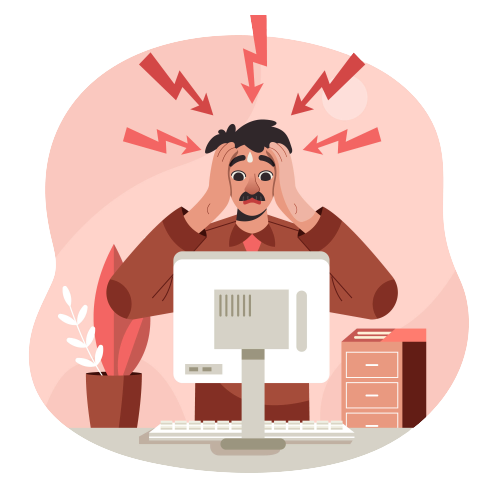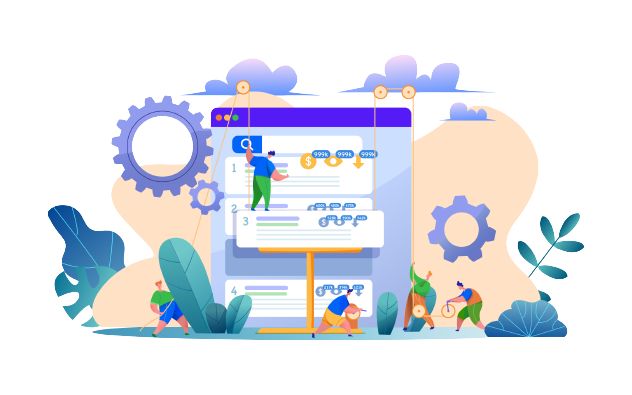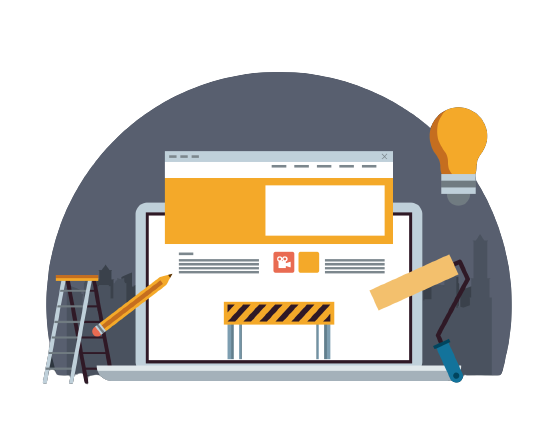
Imagine you’re planning a big online advertising campaign. You have a fantastic offer, a catchy ad, and a special tool called a “landing page builders” to create a webpage that convinces people to buy or sign up for something.
However, many people make mistakes when using this tool. These mistakes can wreck your campaign, just like hidden traps waiting to trip you up.
To help you avoid these pitfalls, we’re going to explore the common blunders people make when using a free landing page builder. By understanding these mistakes, you’ll be better prepared to use these tools effectively in your digital marketing efforts. So, let’s get started on this journey to uncover the secrets of successful landing pages, step by step. But before we discuss these mistakes, let’s start with the basics!
What is a Landing Page?

A landing page is a single web page that is created for a specific marketing or advertising campaign. Its primary purpose is to encourage visitors to take a particular action, such as making a purchase, signing up for a newsletter, downloading an ebook, or filling out a contact form.
Unlike a website’s homepage or other pages, a landing page is highly focused and designed with a clear call to action (CTA) to guide visitors toward that specific goal. Landing pages are often used in digital marketing to increase conversions and track the effectiveness of advertising campaigns. They are usually free from distractions and provide concise information relevant to the campaign’s objective.
Importance of Landing Pages

Landing pages are a fundamental element of digital marketing and online advertising campaigns. They serve a specific and crucial purpose in the sales and lead generation process. There are several reasons why landing pages are important in modern marketing strategies.
- Focused Conversion Goals
One of the primary reasons landing pages are so important is that they allow businesses to set and achieve specific conversion goals. Unlike a website’s homepage or other general pages, landing pages are designed with a single, clear call to action (CTA) in mind. This could be signing up for a newsletter, making a purchase, downloading an e-book, or any other action that aligns with the campaign’s objectives. By keeping the visitor’s attention on a singular goal, landing pages increase the likelihood of conversions.
- Improved User Experience
Landing pages are streamlined and purpose-built, offering a tailored user experience. Visitors who click on an ad or a promotional link expect to find information directly related to what piqued their interest. Landing pages meet these expectations by eliminating distractions and delivering relevant content, which enhances user satisfaction.
- Enhanced Data Collection
Landing pages often include forms for collecting visitor information. This data, which can include names, email addresses, and more, is invaluable for businesses. It helps build a database of leads or potential customers, allowing for personalized follow-up communication and targeted marketing efforts. The data collected on landing pages can inform businesses about their audience’s preferences and needs.
- Increased Conversion Rates
Landing pages are crafted to maximize conversion rates. Marketers can employ various optimization techniques on landing pages, such as compelling headlines, persuasive copywriting, engaging visuals, and strategically placed CTAs. By focusing on these elements and eliminating distractions, landing pages encourage visitors to take the desired action, resulting in higher conversion rates compared to generic web pages.
- A/B Testing and Optimization
Landing pages are ideal for A/B testing. Marketers can create different versions of a landing page to experiment with various elements and approaches. Through A/B testing, businesses can determine which variations yield the best results and make data-driven decisions to continuously improve their campaigns.
- Measurable ROI
The effectiveness of landing pages is easily measurable through analytics. Marketers can track key metrics such as click-through rates, conversion rates, bounce rates, and more. This data allows them to assess the ROI (Return on Investment) of their marketing campaigns accurately. It also helps in identifying areas for improvement and refining marketing strategies.
- Seamless Integration with Advertising Campaigns
Landing pages work seamlessly with various digital advertising channels, including pay-per-click (PPC) advertising, social media ads, email marketing, and affiliate marketing. Marketers can create landing pages specifically tailored to each campaign, ensuring message consistency and improving the chances of campaign success.
- Cost-Efficiency
Compared to creating multiple pages on a website to support different campaigns, landing pages are a cost-effective solution. They require less development time and resources, making them an attractive option for businesses of all sizes.
When used effectively, landing pages can significantly enhance the success of online advertising campaigns and contribute to the overall growth and profitability of a business.
What is a Landing Page Builder?

A landing page builder is a digital tool or software designed to simplify the process of creating and designing landing pages for websites. Landing pages are standalone web pages with a specific purpose: to convert visitors into leads or customers. They are often used in digital marketing campaigns, such as pay-per-click (PPC) advertising, email marketing, and social media promotions.
Here’s a more in-depth look at what a landing page builder entails:
- User-Friendly Interface: Landing page builders are typically equipped with user-friendly drag-and-drop interfaces, making it easy for individuals with little to no coding experience to create professional-looking landing pages. This eliminates the need for hiring a web developer or designer, saving time and resources.
- Pre-Designed Templates: Most landing page builders offer a variety of pre-designed templates tailored to different industries and purposes. These templates serve as starting points for your landing page, allowing you to customize them to fit your brand and campaign goals. Templates often include elements like headlines, images, forms, and calls to action (CTAs).
- Customization Options: Landing page builders provide extensive customization options. You can edit text, change colors, upload images, and adjust layouts to align with your branding and messaging. This flexibility ensures that your landing page reflects your unique identity and communicates your message effectively.
- Integration with Marketing Tools: Many landing page builders integrate seamlessly with other marketing tools and platforms. This includes email marketing services, customer relationship management (CRM) systems, and analytics tools. This integration allows for streamlined data collection and analysis, helping you track the performance of your landing pages and optimize your campaigns.
- Mobile Responsiveness: With the increasing use of mobile devices, landing pages must be mobile-responsive. Landing page builders often include features that ensure your pages look and function well on various screen sizes and devices. This is crucial for providing a positive user experience and maximizing conversions.
- A/B Testing: A key feature of advanced landing page builders is A/B testing or split testing. This allows you to create multiple versions of a landing page with slight variations and test which one performs better in terms of conversion rates. By analyzing the results, you can refine your landing pages over time to achieve higher conversion rates.
- Analytics and Insights: Landing page builders usually come with built-in analytics tools that provide valuable insights into how your pages are performing. You can track metrics such as traffic, bounce rate, conversion rate, and more. These insights help you make data-driven decisions to improve your landing pages and marketing campaigns.
Undoubtedly, a landing page builder is a powerful tool that empowers marketers and business owners to create effective, visually appealing landing pages without the need for extensive technical skills. It simplifies the process of designing and optimizing landing pages, ultimately helping businesses drive more conversions and achieve their marketing goals.
Role of High-Performing Landing Pages in Achieving Marketing Excellence

Landing pages play a crucial role in the success of your online marketing efforts. They serve as the gateway for potential customers to enter your sales funnel and take a desired action, whether that’s making a purchase, signing up for a newsletter, or requesting more information. Understanding the importance of effective landing pages is essential for anyone using landing page builders, as it directly impacts your conversion rates and overall marketing success.
- First Impressions Matter: Landing pages are often the first point of contact between your audience and your business. A well-designed and persuasive landing page can make a positive first impression, instilling trust and credibility in your brand. On the contrary, a poorly constructed landing page can drive potential customers away before they even explore your offerings.
- Maximizing Conversion Rates: The primary goal of a landing page is to convert visitors into leads or customers. An effective landing page can significantly increase your conversion rates by presenting a clear and compelling message, enticing offers, and a user-friendly experience. When done right, it can be a powerful tool for boosting your bottom line.
- Tailored Messaging: Unlike your website’s homepage, which serves multiple purposes, a landing page is specifically designed for a single purpose. This focused approach allows you to tailor your messaging to a particular audience and product or service, making it highly relevant to the visitors who land on it. Relevant messaging increases the chances of conversion.
- Data Collection: Landing pages are excellent tools for collecting valuable customer data. By using forms and lead capture mechanisms, you can gather information about your audience, such as email addresses, names, and even demographic details. This data can be used for future marketing efforts, segmenting your audience, and personalizing your messaging.
- Measurable Results: Landing pages are easily trackable, making it straightforward to measure their performance. You can use analytics tools to monitor metrics like bounce rate, conversion rate, and click-through rate, providing insights into what’s working and what needs improvement. This data-driven approach allows for continuous optimization and refinement.
- Cost-Effective Marketing: Effective landing pages can reduce your marketing costs by ensuring that you’re targeting the right audience with the right message. When your landing pages are optimized for conversions, you can get more value from your advertising spend, whether it’s through pay-per-click (PPC) campaigns, social media ads, or email marketing.
- A/B Testing Opportunities: Landing pages are ideal for A/B testing, where you can create variations of a page to determine which elements perform best. By experimenting with different headlines, images, copy, and call-to-action buttons, you can refine your landing page to achieve optimal results over time.
Thus, you cannot overstate the importance of effective landing pages. They serve as the linchpin of your digital marketing strategy, driving conversions, capturing leads, and delivering measurable results.
Top Mistakes in Landing Page Design

When it comes to creating effective landing pages, design plays a crucial role. A well-designed landing page can significantly improve your conversion rates, while poor design choices can drive potential customers away. Let’s discuss some top mistakes in landing page design and explain each one in detail:
- Cluttered Layout: A cluttered landing page overwhelms visitors and makes it difficult for them to focus on the key message or call to action (CTA). Avoid cramming too much information, images, or elements onto the page. Instead, maintain a clean, organized layout with ample white space to guide the visitor’s attention where it matters most.
- Unclear Headlines: Your headline is often the first thing visitors see, and it should convey a clear and compelling message. Avoid vague or ambiguous headlines that leave visitors guessing. Make it concise, benefit-oriented, and relevant to your offer.
- Poor Visual Hierarchy: Visual hierarchy is about guiding the visitor’s eye through the page, emphasizing the most important elements. Common mistakes include placing the CTA in an inconspicuous location, using inconsistent font sizes, or failing to use contrasting colors to highlight essential elements. Establish a clear visual hierarchy that directs attention to your CTA and key selling points.
- Lack of Visual Consistency: Inconsistent colors, fonts, and imagery can make your landing page look unprofessional and confusing. Ensure that your landing page design aligns with your brand’s visual identity and maintains a consistent look and feel across all elements.
- Lengthy Forms: Lengthy or overly complex forms can be a major turn-off for visitors. Asking for too much information upfront can deter potential leads. Keep your forms concise and request only essential information. You can collect more details later in the customer journey.
- Slow Loading Speed: Slow-loading landing pages frustrate visitors and increase bounce rates. Image-heavy pages, excessive scripts, or poor hosting can contribute to slow loading times. Optimize images, minimize code, and choose a reliable hosting provider to ensure your landing pages load quickly.
- Lack of Mobile Optimization: With the majority of internet users accessing websites on mobile devices, it’s crucial to ensure your landing pages are mobile-responsive. Failing to optimize for mobile can result in a poor user experience, leading to missed opportunities. Test your landing pages on various mobile devices to guarantee they display correctly and function smoothly.
- Lack of Trust Signals: Building trust is crucial for converting visitors into customers. Neglecting to include trust signals like customer reviews, testimonials, security badges, or recognizable brand logos can make visitors skeptical of your offer. Incorporate these elements to instill confidence in your audience.
- Absence of A/B Testing: Not testing and optimizing your landing pages can result in missed opportunities for improvement. A/B testing allows you to compare different elements (such as headlines, CTAs, images, or colors) to identify what works best for your audience. Neglecting this valuable practice can prevent you from maximizing your conversion rates.
- Poor Typography Choices: Typography significantly impacts readability. Using overly complex or illegible fonts can deter visitors from engaging with your content. Choose fonts that are easy to read and maintain a consistent typeface throughout your landing page.
- Misuse of Images and Visuals: While visuals can enhance a landing page, using irrelevant or low-quality images can have the opposite effect. Ensure that images and graphics support your message and are of high quality. Avoid excessive or distracting animations that may annoy visitors.
- Ignoring Loading Errors: Error messages or broken links can disrupt the user experience and erode trust. Regularly check for and fix any loading errors on your landing pages to ensure a seamless browsing experience.
- Neglecting Page Speed: Slow-loading pages have already been mentioned, but it’s worth emphasizing how crucial page speed is. Even a few extra seconds of loading time can lead to higher bounce rates. Compress images, minify code, and utilize content delivery networks (CDNs) to improve page speed.
- Overcomplicating Navigation: Landing pages should have a singular focus on the desired action, whether it’s signing up for a newsletter or making a purchase. Avoid including unnecessary navigation links that might distract visitors from your primary CTA. Keep the path to conversion straightforward.
- Inadequate Testing and Feedback: Failing to gather user feedback and conduct usability testing can lead to blind spots in your design. Solicit feedback from real users and make data-driven improvements to your landing pages based on their input.
Avoiding these top mistakes in landing page design is essential for achieving higher conversion rates and a better user experience. By creating clean, well-organized, and visually appealing landing pages that cater to your audience’s needs, you can maximize the effectiveness of your online marketing efforts.
Conversion-Killing Form and Call-To-Action Blunders
Forms and call-to-actions (CTAs) are essential elements of any website or landing page. They are the gateways through which visitors can convert into leads or customers. However, if not designed properly, forms and CTAs can actually kill conversions.
Here are some of the most common conversion-killing form and CTA blunders:
Form blunders
- Too many fields: People are more likely to abandon a form if it has too many fields to fill out. Only ask for the information you absolutely need.
- Confusing or ambiguous fields: Make sure your form fields are clear and easy to understand. Avoid using jargon or technical terms.
- Required fields that are not clearly marked: Make it clear which fields are required and which are optional.
- No error messages: When a visitor makes a mistake on your form, provide helpful error messages that tell them what they did wrong and how to fix it.
- No submit button: Make sure your form has a clear and visible submit button.
CTA blunders
- Weak or unclear copy: Your CTA should be clear and concise, and it should tell visitors exactly what you want them to do. Avoid using general language like “Click here.”
- A CTA that leads to the wrong page: When a visitor clicks on your CTA, it should take them to the page you promised. Avoid sending them to the wrong page or a page that doesn’t exist.
- Not using a contrasting color: Your CTA should stand out from the rest of your content. Use a contrasting color to make your CTA more visible.
- Not placing your CTA in a prominent location: Your CTA should be placed in a prominent location on your page, where visitors are likely to see it. Avoid placing it at the bottom of the page or in a hard-to-find spot.
- Not testing different CTAs: It’s important to test different CTAs to see what works best for your audience. Try different variations of your CTA copy, placement, and design.
By avoiding these common blunders, you can create forms and CTAs that will help you improve your conversion rates.
Conclusion
In digital marketing, steering clear of common landing page builders pitfalls is essential for achieving conversion success. To craft high-performing landing pages, simplify your design, grab attention with compelling headlines, optimize for speed and mobile responsiveness, and conduct A/B testing for continuous improvement. Engage your audience with persuasive content, master form, and call-to-action elements, build credibility through social proof, and instill urgency where relevant. Landing page optimization is an ongoing journey, ensuring your pages remain effective tools for driving conversions and meeting your marketing objectives.